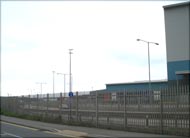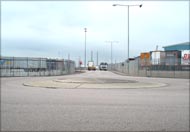Tilbury Hospital
Ferry Road, Tilbury, Essex
Medical dates:
Medical character:
Acute
The Tilbury Docks were built on
a site of mostly uninhabited marshland. Up to 6,000 men were
employed in their construction. Workers lived in huts which were
provided by the dock company or travelled in from surrounding villages.
The sudden influx of people caused a housing shortage and
overcrowding. The town of Tilbury grew from the need of local
accommodation for the dockworkers and their families.
During construction of the docks, fatalities and accident rates were high, but Tilbury had no hospital. An injured or sick person had to be sent to the London Hospital in Whitechapel or transferred by ferry to Gravesend on the other side of the Thames.
From 1882 efforts by Friendly Societies and others were made to establish a cottage hospital at Tilbury for the growing medical needs of the population, but to no avail. In 1894 a Mr Ephraim Wright wrote to the Cornish philanthropist John Passmore Edwards for help. Passmore Edwards responded promptly by offering to supply a suitable building.
Land opposite the dock gates, south of the railway line, was provided by the Tilbury Dock Company (who also contributed £250 for the foundations) and Passmore Edwards himself laid the foundation stone in 1895.
The Tilbury Cottage Hospital opened in 1896. The small single-storey cottage had cost £2,000 to build. It had 8 beds - two large wards with three beds each and two single rooms. The President of the Hospital, Mr E. Hughes, paid for the laying out and planting of the garden. The staff consisted of a Matron, one Day and one Night Nurse and two domestic servants.
In 1901 the Hospital was enlarged on its southern side with the addition of three wards containing an extra 12 beds.
However, by the early 1920s, as the docks expanded with consequent increasing demands made on the Hospital, the Hospital Committee felt a larger building with more modern equipment was necessary. In 1923 the Seamen's Hospital Society, which was responsible for the care and treatment of all sick and injured seamen in the whole Port of London, agreed to take over administration of the Hospital. This was effected in January 1924. The Society renamed it the Tilbury Hospital. An X-ray machine had been installed and a new operating theatre, kitchen and boiler block added at the cost of £35,000 before the transfer took place. A Mr Singhanee, from Pune, India, had donated £6,732 to the Hospital for the provision and endowment of a ward for Indian seamen, and the Singhanee Ward (a former WW1 hut) had been almost erected by this time. The original cottage hospital building became the Passmore Edwards Ward.
In June 1924 the new Tilbury Hospital with 50 beds was opened by the Duke of York. The Duke also laid the foundation stone for further new buildings - two wards with 22 beds each and a Nurses' Home. These were completed in 1925, after which the Hospital had 94 beds. An Out-Patients Department had also been added. The buildings were made of concrete and had metal frame windows. They had to be built on concrete rafts because of the poor load-bearing capabilities of the marshy land. The Hospital was later known as the 'concrete hospital'.
The Hospital survived the Depression years of the 1930s, despite financial pressure on it. It continued under the management of the Seamen's Hospital Society until 1948, when it joined the NHS under the control of the South Essex Hospital Management Committee, part of the North East Metropolitan Regional Hospital Board. It served the Urban Districts of Billericay and Thurrock - the only acute surgical hospital in the area.
In 1950, when it had 74 beds, it became the Tilbury branch of the Tilbury and Riverside General Hospital, which was a combination of the Tilbury and Orsett Hospitals. In 1953 Orsett Hospital was chosen to be the main hospital for the Thurrock area.
In 1969 the Tilbury Hospital closed and all services transferred to the Orsett Hospital.
During construction of the docks, fatalities and accident rates were high, but Tilbury had no hospital. An injured or sick person had to be sent to the London Hospital in Whitechapel or transferred by ferry to Gravesend on the other side of the Thames.
From 1882 efforts by Friendly Societies and others were made to establish a cottage hospital at Tilbury for the growing medical needs of the population, but to no avail. In 1894 a Mr Ephraim Wright wrote to the Cornish philanthropist John Passmore Edwards for help. Passmore Edwards responded promptly by offering to supply a suitable building.
Land opposite the dock gates, south of the railway line, was provided by the Tilbury Dock Company (who also contributed £250 for the foundations) and Passmore Edwards himself laid the foundation stone in 1895.
The Tilbury Cottage Hospital opened in 1896. The small single-storey cottage had cost £2,000 to build. It had 8 beds - two large wards with three beds each and two single rooms. The President of the Hospital, Mr E. Hughes, paid for the laying out and planting of the garden. The staff consisted of a Matron, one Day and one Night Nurse and two domestic servants.
In 1901 the Hospital was enlarged on its southern side with the addition of three wards containing an extra 12 beds.
However, by the early 1920s, as the docks expanded with consequent increasing demands made on the Hospital, the Hospital Committee felt a larger building with more modern equipment was necessary. In 1923 the Seamen's Hospital Society, which was responsible for the care and treatment of all sick and injured seamen in the whole Port of London, agreed to take over administration of the Hospital. This was effected in January 1924. The Society renamed it the Tilbury Hospital. An X-ray machine had been installed and a new operating theatre, kitchen and boiler block added at the cost of £35,000 before the transfer took place. A Mr Singhanee, from Pune, India, had donated £6,732 to the Hospital for the provision and endowment of a ward for Indian seamen, and the Singhanee Ward (a former WW1 hut) had been almost erected by this time. The original cottage hospital building became the Passmore Edwards Ward.
In June 1924 the new Tilbury Hospital with 50 beds was opened by the Duke of York. The Duke also laid the foundation stone for further new buildings - two wards with 22 beds each and a Nurses' Home. These were completed in 1925, after which the Hospital had 94 beds. An Out-Patients Department had also been added. The buildings were made of concrete and had metal frame windows. They had to be built on concrete rafts because of the poor load-bearing capabilities of the marshy land. The Hospital was later known as the 'concrete hospital'.
The Hospital survived the Depression years of the 1930s, despite financial pressure on it. It continued under the management of the Seamen's Hospital Society until 1948, when it joined the NHS under the control of the South Essex Hospital Management Committee, part of the North East Metropolitan Regional Hospital Board. It served the Urban Districts of Billericay and Thurrock - the only acute surgical hospital in the area.
In 1950, when it had 74 beds, it became the Tilbury branch of the Tilbury and Riverside General Hospital, which was a combination of the Tilbury and Orsett Hospitals. In 1953 Orsett Hospital was chosen to be the main hospital for the Thurrock area.
In 1969 the Tilbury Hospital closed and all services transferred to the Orsett Hospital.
Present status (May 2008)
The Hospital has been completely demolished and no traces of it remain. The site is now part of the Tilbury freight depot.
The Hospital has been completely demolished and no traces of it remain. The site is now part of the Tilbury freight depot.

The presumed site of the Hospital

The freight terminal building from a distance

Looking across the presumed site at the road leading to the docks

Looking down Ferry Road to the Tilbury Ferry terminal
(Author unstated) 1894 Cottage hospital at Tilbury. British Medical Journal 1 (1736), 732.
(Author unstated) 1897 Nursing echoes. British Journal of Nursing, 28th August, 173.
http://hospitalshistory.multiply.com
http://unlockingessex.essexcc.gov.uk
www.lawcom.gov.uk (pp. 116-117)
www.passmoreedwards.org.uk
www.svvs.org
Return to home page